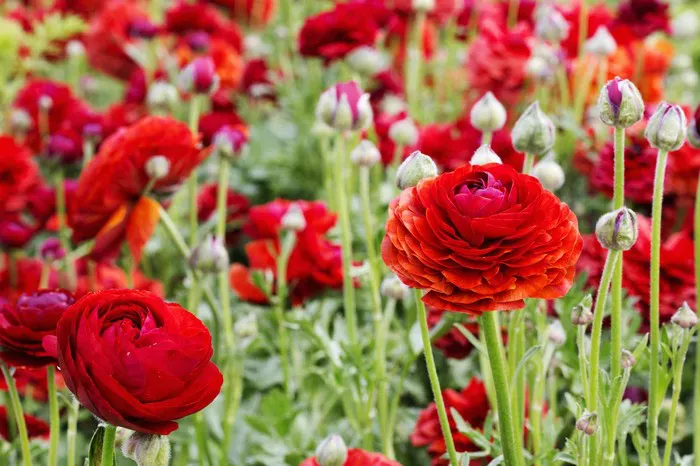Ranunculus flowers, with their delicate petals and vibrant colors, are a favorite among gardeners and florists alike. Their beauty is fleeting, however, as fresh flowers eventually wilt and fade. Fortunately, by employing proper drying techniques, you can preserve the elegance of ranunculus blooms for months or even years to come. In this comprehensive guide, we will explore various methods for drying ranunculus flowers, ensuring that their charm remains intact long after they are plucked from the garden.
Understanding Ranunculus Flowers
Before delving into the drying process, it is essential to understand the anatomy of ranunculus flowers. Ranunculus, belonging to the Ranunculaceae family, boasts a diverse range of species, with the most common being the Persian buttercup (Ranunculus asiaticus). These flowers feature multiple layers of delicate, papery petals, often resembling miniature peonies or roses. They come in an array of hues, including vibrant reds, soft pinks, sunny yellows, and creamy whites, making them a popular choice for bouquets and floral arrangements.
Selecting the Perfect Specimens
To ensure successful drying, it is crucial to start with high-quality ranunculus blooms. Choose flowers that are fully open but not yet past their prime. Look for petals that are free from blemishes, bruises, or signs of decay. Selecting healthy specimens at the peak of their beauty will yield the best results when dried.
Methods of Drying
There are several methods available for drying ranunculus flowers, each offering its own advantages and considerations. Below, we explore three popular techniques:
1. Air Drying:
Air drying is one of the simplest and most traditional methods of preserving flowers. To air dry ranunculus blooms, gather them into small bunches, securing the stems with twine or rubber bands. Hang the bunches upside down in a well-ventilated, dark area, such as a closet or attic. Ensure that the flowers are not overcrowded, allowing adequate airflow between each bloom. Over the course of several weeks, the flowers will gradually dry, maintaining their shape and color.
Air drying is ideal for preserving the natural appearance of ranunculus flowers, as it minimizes shrinkage and maintains petal structure. However, this method requires patience, as the drying process can take several weeks to complete.
2. Silica Gel Drying:
Silica gel is a desiccant commonly used for drying flowers. Unlike air drying, which relies on evaporation, silica gel works by absorbing moisture from the flowers, preserving them quickly and efficiently. To dry ranunculus flowers with silica gel, pour a layer of the desiccant into a container with a lid. Gently place the flowers on top of the silica gel, ensuring that they are not touching each other or the sides of the container. Carefully cover the flowers with additional silica gel, ensuring that they are completely submerged. Seal the container and allow the flowers to dry for several days to a week, depending on their size and thickness.
Silica gel drying offers the advantage of preserving the vibrant colors of ranunculus flowers, as the desiccant absorbs moisture without causing wilting or discoloration. Additionally, this method is relatively quick, producing dried flowers in a matter of days rather than weeks.
3. Pressing:
Pressing is a classic method of preserving flowers, ideal for creating flat, two-dimensional arrangements. To press ranunculus flowers, place them between layers of absorbent paper, such as newspaper or blotting paper. Arrange the flowers in a single layer, ensuring that they do not overlap. Carefully place additional layers of paper on top of the flowers, pressing down gently to flatten them. Place heavy books or a flower press on top of the layers to apply pressure evenly. Leave the flowers to dry for several weeks, replacing the absorbent paper as needed.
Pressing is well-suited for creating botanical art or decorative crafts using dried flowers. While it may not preserve the three-dimensional beauty of ranunculus blooms, pressing offers a unique way to showcase their intricate details and colors.
Post-Drying Preservation
Once your ranunculus flowers are thoroughly dried, it is essential to take steps to preserve their beauty for the long term. Here are some tips for ensuring the longevity of your dried blooms:
1. Sealing: To protect dried flowers from dust, humidity, and pests, consider sealing them in airtight containers or display cases. Clear resin or acrylic spray can also be applied to provide an extra layer of protection.
2. Storage: Store dried ranunculus flowers in a cool, dry place away from direct sunlight. Avoid areas with high humidity, as moisture can cause the flowers to become limp or moldy over time.
3. Handling: Handle dried flowers with care to prevent breakage or damage to delicate petals. Avoid touching them unnecessarily, and store them in a location where they are unlikely to be disturbed.
4. Display: Showcase your dried ranunculus flowers in decorative arrangements, shadow boxes, or frames. Incorporate them into wreaths, bouquets, or centerpieces for a touch of timeless elegance.
Conclusion
By following these guidelines, you can enjoy the beauty of ranunculus flowers long after their fresh counterparts have faded away. Whether air drying, using silica gel, or pressing, each method offers a unique way to preserve the charm and allure of these exquisite blooms. With proper care and attention, your dried ranunculus flowers will continue to bring joy and inspiration for years to come.


